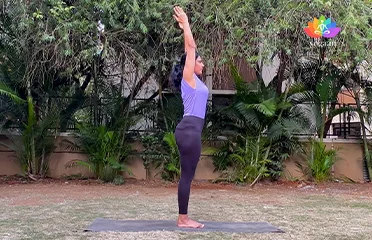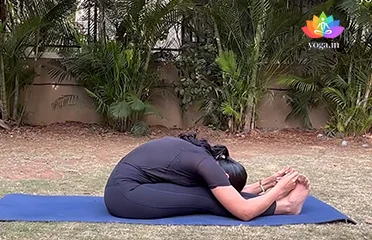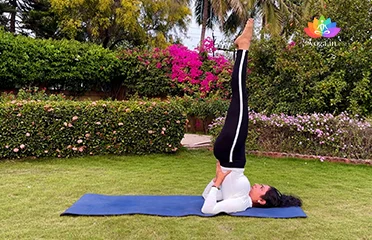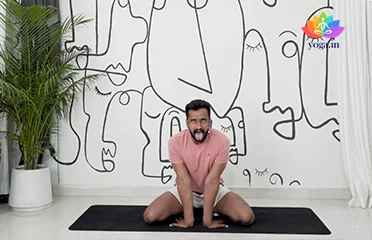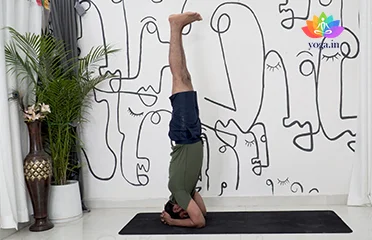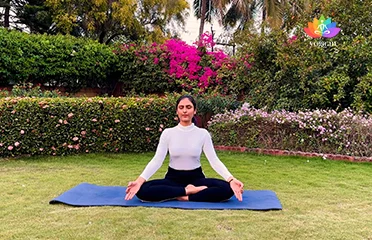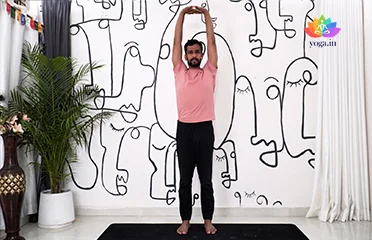Hastapadasana (Hand to Foot Pose)
हस्तपदासन / Hand to Foot Pose
The sanskrit name is derived from hasta (हस्त) means hands, pada (पदा) [�K]
Paschimottanasana (Seated Forward Bend)
पश्चिमोत्तानासन / Seated Forward Bend
The Sanskrit name is derived from three sanskrit words: Paschima (पश्चिमा) [�K]
Sarvangasana (Shoulderstand)
सर्वाङ्गासनI / Shoulderstand
The Sanskrit name is derived from Sarva (सर्वाङ्ग) meaning all, [�K]
Simhasana (Lion Pose)
सिंहासना / Lion Pose
The Sanskrit name is derived from Simha (सिंहा) which means lion and [�K]
Sirsasana (Headstand)
शीर्षासन / Headstand
The Sanskrit name is derived from Sirsa (शीर्ष) meaning head and asana [�K]
Svastikasana (Auspicious Pose)
स्वस्तिकासन / Auspicious Pose
The Sanskrit name is derived from Swastika (स्वस्तिका) meaning [�K]
Tadasana (Mountain Pose)
ताड़ासन / Mountain Pose
The sanskrit name is derived from tada (ताड़ा) meaning mountain and [�K]
How Yoga Can Help Cure Eyes:
Eyes are not just the windows to the soul; they’re also crucial for our daily functioning, allowing us to perceive the world around us. However, they can sometimes face challenges, from strain due to prolonged screen time to more severe conditions like myopia or astigmatism. Thankfully, yoga offers a holistic approach to eye care, promoting both physical and mental well-being.
Yoga aids in treating and relieving various eye conditions by incorporating gentle movements, mindful breathing, and relaxation techniques. Through a combination of eye exercises, meditation, and asanas specifically targeting the ocular muscles, yoga can enhance blood circulation, reduce strain, and promote overall eye health.
Understanding Eyes:
Eyes are marvels of biological engineering, allowing us to perceive light and color, and interpret the world around us. From the intricate structure of the iris to the delicate layers of the retina, the eyes play a vital role in our sensory experience.
However, like any part of the body, the eyes can face challenges. From common issues like dry eyes or eye strain to more serious conditions such as glaucoma or cataracts, understanding the complexities of eye health is essential for maintaining clear vision and preventing discomfort.
Yoga’s Role in Relieving Eyes:
Specific yoga practices can provide relief for various eye-related discomforts. Gentle eye exercises, such as palming or eye rotations, can alleviate strain and tension, while mindfulness techniques like Trataka meditation can enhance focus and visual clarity.
Additionally, incorporating relaxation poses like Savasana or gentle forward bends into your yoga routine can help reduce overall stress levels, which can indirectly benefit eye health by minimizing tension in the facial muscles and promoting relaxation throughout the body.
Key Factors Contributing to Eyes:
Several factors can contribute to eye discomfort and vision problems, including:
- Prolonged Screen Time: Excessive use of digital devices can strain the eyes and lead to symptoms like dryness and fatigue.
- Environmental Factors: Exposure to harsh lighting, pollutants, or allergens can irritate the eyes and exacerbate existing conditions.
- Age-related Changes: As we age, the eyes undergo natural changes, such as decreased tear production or changes in lens flexibility, which can affect vision.
- Genetic Predisposition: Family history can play a role in certain eye conditions, such as myopia or glaucoma.
- Lifestyle Choices: Poor nutrition, lack of exercise, and inadequate eye care habits can contribute to eye health issues over time.
Symptoms of Eyes:
Common symptoms associated with eye discomfort include:
- Eye Fatigue: Feeling tired or strained after prolonged visual tasks.
- Dryness: Sensation of dryness or irritation in the eyes.
- Blurriness: Difficulty focusing or seeing clearly, especially at close distances.
- Redness: Inflammation or redness in the eyes, often accompanied by itching or burning.
- Sensitivity to Light: Discomfort or pain when exposed to bright light or glare.
- Headaches: Recurrent headaches, especially around the temples or forehead, often associated with eye strain.
- Double Vision: Seeing overlapping or duplicated images, particularly when focusing on near objects.
- Difficulty Adjusting to Light Changes: Struggling to adapt to changes in lighting conditions, such as going from a dark room to a brightly lit environment.
Treatment of Eyes through Yoga and Pranayama:
Yoga offers effective techniques for alleviating eye discomfort and promoting overall eye health. Some beneficial practices include:
Specific Yoga Poses:
- Palming: Sit comfortably with eyes closed and palms warmed by rubbing them together. Gently cup the palms over the eyes without applying pressure, allowing the warmth to soothe and relax the eyes.
- Blinking Exercises: Sit with eyes open and blink rapidly for 10-15 seconds, then close the eyes and rest for a few breaths. Repeat several times to refresh and lubricate the eyes.
- Eye Rotations: Sit comfortably and slowly rotate the eyes in a circular motion, first clockwise and then counterclockwise. Focus on smooth, controlled movements and breathe deeply throughout.
Pranayama Exercises:
Bhramari Pranayama (Humming Bee Breath): Sit comfortably with eyes closed and take a deep breath in. As you exhale, make a humming sound like a bee, feeling the vibrations resonate throughout the head and eyes. Repeat for several rounds to calm the mind and soothe the eyes.
Diet for Eyes:
In addition to yoga practices, maintaining a healthy diet rich in nutrients essential for eye health can further support your vision. Consider including foods high in:
- Vitamin A: Found in carrots, sweet potatoes, and leafy greens, vitamin A supports retinal health and night vision.
- Omega-3 Fatty Acids: Incorporate sources like fatty fish, flaxseeds, and walnuts to support tear production and reduce inflammation.
- Antioxidants: Foods rich in antioxidants, such as berries, citrus fruits, and bell peppers, can help protect the eyes from oxidative stress and age-related damage.
Caution for Eyes:
While yoga can offer significant benefits for eye health, it’s essential to practice with awareness and sensitivity to your body’s needs. Some precautions to keep in mind include:
- Avoid Straining: If you experience discomfort or pain during any eye exercises or poses, gently release and rest your eyes.
- Limit Screen Time: Take regular breaks from digital devices to reduce eye strain and prevent fatigue.
- Protect Your Eyes: Wear sunglasses outdoors to shield your eyes from harmful UV rays, and consider using artificial tears if you experience dryness or irritation.
Contraindications for Eyes:
Individuals with certain eye conditions or health concerns should approach yoga practices for eye health with caution. If you have:
- Severe Eye Infections: Avoid practices that involve touching or rubbing the eyes to prevent further irritation or infection.
- Recent Eye Surgery: Consult with your healthcare provider before engaging in any yoga practices that may strain or compromise the healing process.
- Chronic Eye Conditions: If you have a history of retinal detachment, glaucoma, or other serious eye conditions, consult with an eye care specialist before attempting any new exercises or techniques


